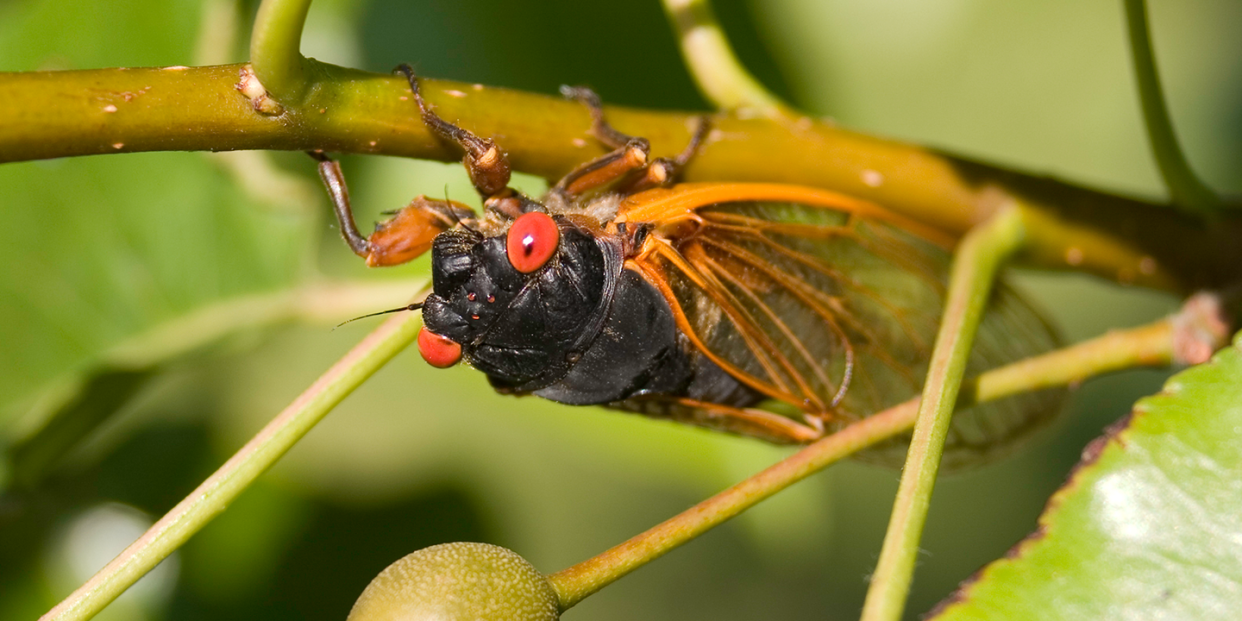Millions of Cicadas From Brood X Will Soon Take Over the Eastern U.S.

In case you’re not familiar with cicadas, the loud, bulbous-eyed bugs emerge from the ground after a certain period of time to make lots of noise, find a mate, snack on trees, and hang out everywhere. Some species come out of the ground every spring and summer, while other cicadas stay burrowed for more than a decade.
So, after a rather turbulent year, you might want to prepare yourself: A massive group of cicadas known as Brood X (read: Brood 10) will emerge as soon as April—and they’re going to blanket a huge portion of the eastern U.S.
Brood X cicadas last came out by the millions in 2004. This year, they’ll hang out for four to six weeks to mate before dying off and resurfacing in the year 2038.
Millions of cicadas heading your way? You probably have some questions. So, pull up a seat: We talked to entomologists (a.k.a. bug experts) for all the deets on this insect phenomenon.
What is Brood X, exactly?
Cicadas can generally be lumped into two groups, depending on the species: annual cicadas, which come out every year, and periodical cicadas, which emerge every 13 to 17 years, says Godfrey Nalyanya, Ph.D., an associate certified entomologist with Ehrlich Pest Control.
These insects, including those in Brood X (a.k.a. the Great Eastern Brood), start their lives as eggs laid in trees. After they hatch, they fall out of the trees and burrow into the ground. Once they’re settled, they feed on fluids from the tree through its roots as they grow slowly. Eventually, as the soil warms up, they emerge from the ground as adult cicadas.
Brood X is a group of 17-year cicadas and features three different species: Magicicada septendecim, Magicicada cassini, and Magicicada septendecula, says Frank Meek, technical services manager at Rollins pest control, with Magicicada cassini being the most common.
How big are the cicadas in Brood X?
They are pretty sizable insects and measure between one to two inches in length, meaning they “are slightly smaller than annual cicadas,” Nalyanya says. Periodical cicadas also usually have black bodies, orange wing veins, red eyes and six legs, and “they are often sluggish or slower moving,” he adds.
Annual cicadas, on the other hand, move faster and are green-brown in color. These bugs tend to emerge in July and stick around through September, which is why we tend to associate cicada sounds with summer.
Where will Brood X cicadas emerge?
Brood X spans the largest geographic area of the 17-year cicadas, according to the University of Connecticut, which has a handy map of where you can expect to find the most cicadas in varying regions. “Their range is going to be from north Georgia and way up the east coast of the U.S.,” Meek says. But they’re expected to stretch west a little as well.
If you live in one of these states, Nalyanya says you can expect to see some Brood X activity in a few weeks. The amount is expected to vary depending on your location:
Delaware
Georgia
Illinois
Indiana
Kentucky
Maryland
Michigan
North Carolina
New Jersey
New York
Ohio
Pennsylvania
Tennessee
Virginia
West Virginia
Washington, D.C.
How many cicadas will there be in Brood X?
You may have heard some claims that this brood contains billions of cicadas, but Meeks calls that an “exaggeration.”
Instead, Nalyanya says, “there will be hundreds of thousands—if not millions of cicadas—emerging from the ground around homes and businesses” in the states listed above. “So, expect lots of large, black-bodied cicadas and their accompanying sounds,” he adds.
What will Brood X cicadas sound like?
Because there are a few different species, they can make different sounds—all of which tend to be noisy. “The sound is similar to a loud buzzing, head-splitting noise,” Nalyanya says. “In general, there are hundreds of thousands of emerging bugs sounding off at the same time and that can be pretty loud. It may be heard from miles away.”
The noise, Meek says, is a mating call. “The males try to attract a female so they can procreate,” he says. You can hear the noise pretty much all the time, although Nalyanya says that periodical cicadas are least active at night and early morning when the temperature is cooler. “Cicadas generally call during daylight hours and at dusk,” he adds.
Can the Brood X cicadas hurt you? Are they dangerous at all?
No, they’re pretty harmless. However, keep this in mind, per Nalyanya: Large numbers of nymphs (immature bugs) on young trees or shrubs can damage them. (So, if you have lots of plants you’d like to protect, read up on how to prepare for a cicada swarm here.)
While cicadas can be annoying and pretty gross—especially because they will molt and leave behind cast skins—Meek recommends looking at the positives of Brood X’s emergence: “It’s just a wonder of nature.”
Go here to join Prevention Premium (our best value, all-access plan), subscribe to the magazine, or get digital-only access.
You Might Also Like
